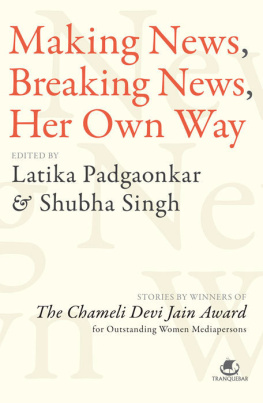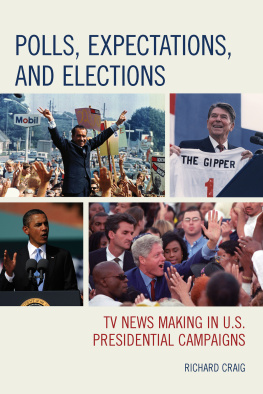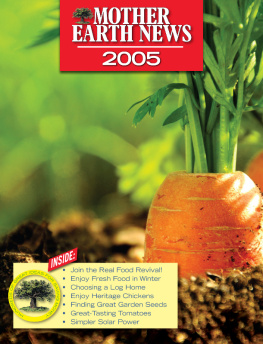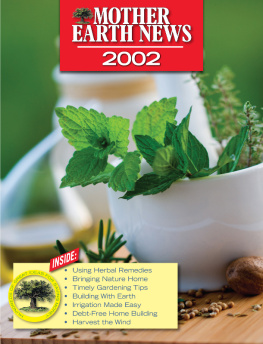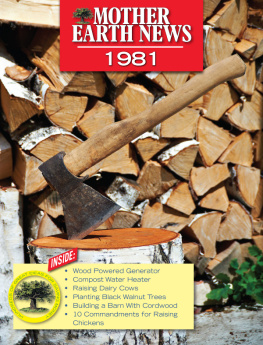Latika Padgaonkar [Padgaonkar - Making News, Breaking News
Here you can read online Latika Padgaonkar [Padgaonkar - Making News, Breaking News full text of the book (entire story) in english for free. Download pdf and epub, get meaning, cover and reviews about this ebook. year: 2012, publisher: Westland Publishing, genre: Politics. Description of the work, (preface) as well as reviews are available. Best literature library LitArk.com created for fans of good reading and offers a wide selection of genres:
Romance novel
Science fiction
Adventure
Detective
Science
History
Home and family
Prose
Art
Politics
Computer
Non-fiction
Religion
Business
Children
Humor
Choose a favorite category and find really read worthwhile books. Enjoy immersion in the world of imagination, feel the emotions of the characters or learn something new for yourself, make an fascinating discovery.
- Book:Making News, Breaking News
- Author:
- Publisher:Westland Publishing
- Genre:
- Year:2012
- Rating:3 / 5
- Favourites:Add to favourites
- Your mark:
- 60
- 1
- 2
- 3
- 4
- 5
Making News, Breaking News: summary, description and annotation
We offer to read an annotation, description, summary or preface (depends on what the author of the book "Making News, Breaking News" wrote himself). If you haven't found the necessary information about the book — write in the comments, we will try to find it.
Latika Padgaonkar [Padgaonkar: author's other books
Who wrote Making News, Breaking News? Find out the surname, the name of the author of the book and a list of all author's works by series.
Making News, Breaking News — read online for free the complete book (whole text) full work
Below is the text of the book, divided by pages. System saving the place of the last page read, allows you to conveniently read the book "Making News, Breaking News" online for free, without having to search again every time where you left off. Put a bookmark, and you can go to the page where you finished reading at any time.
Font size:
Interval:
Bookmark:

MAKING NEWS, BREAKING NEWS, HER OWN WAY

An imprint of westland ltd
Venkat Towers, 165, P.H. Road, Opp. Maduravoyal Municipal office, Chennai 600 095
No. 38/10 (New No.5), Raghava Nagar, New Timber Yard Layout, Bangalore 560 026
Survey No. A-9, II Floor, Moula Ali Industrial Area, Moula Ali, Hyderabad 500 040
23/181, Anand Nagar, Nehru Road, Santacruz East, Mumbai 400 055
4322/3, Ansari Road, Daryaganj, New Delhi 110 002
B G Verghese
Devaki Jain
Neerja Chowdhury
Barkha Dutt
Sevanti Ninan
Shahnaz Anklesaria Aiyar
Sakuntala Narasimhan
Sheela Barse
Madhu Purnima Kishwar
Kalpana Sharma
Tavleen Singh
Chitra Subramaniam
Usha Rai
Pushpa Girimaji
Shohini Ghosh, Sabina Kidwai, Shikha Jhingan, Ranjani Mazumdar, Sabeena Gadihoke and Charu Gargi
Sucheta Dalal
Teesta Setalvad
Alka Raghuvanshi
Manimala
Sheela Bhatt
Shubha Singh
Annam Suresh
Rehana Hakim
Anita Pratap
Pamela Philipose
THE LIFE AND TIMES OF HOMAI VYARAWALLA
Sabeena Gadihoke
Homai Vyarawalla
Vasavi Kiro
Priti Soni
Bano Haralu
Shikha Trivedy
Sonu Jain
Shalini Joshi and Disha Mullick
Sunita Narain
Ratna Bharali Talukdar
Nilanjana Bose
Sreerekha B
Rupashree Nanda
Nirupama Subramanian
Vinita Deshmukh
Tiamerenla Monalisa Changkija
Font size:
Interval:
Bookmark:
Similar books «Making News, Breaking News»
Look at similar books to Making News, Breaking News. We have selected literature similar in name and meaning in the hope of providing readers with more options to find new, interesting, not yet read works.
Discussion, reviews of the book Making News, Breaking News and just readers' own opinions. Leave your comments, write what you think about the work, its meaning or the main characters. Specify what exactly you liked and what you didn't like, and why you think so.

